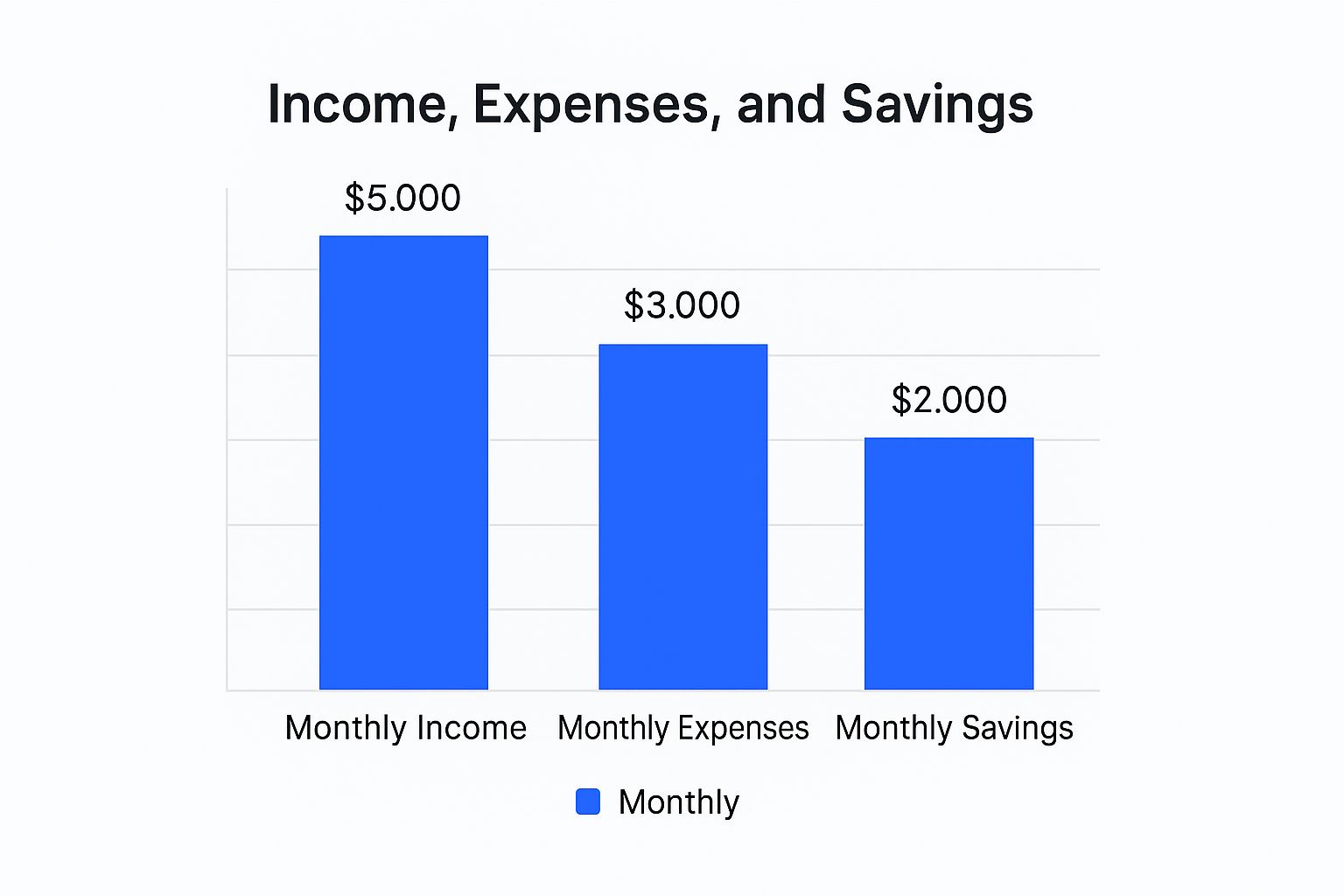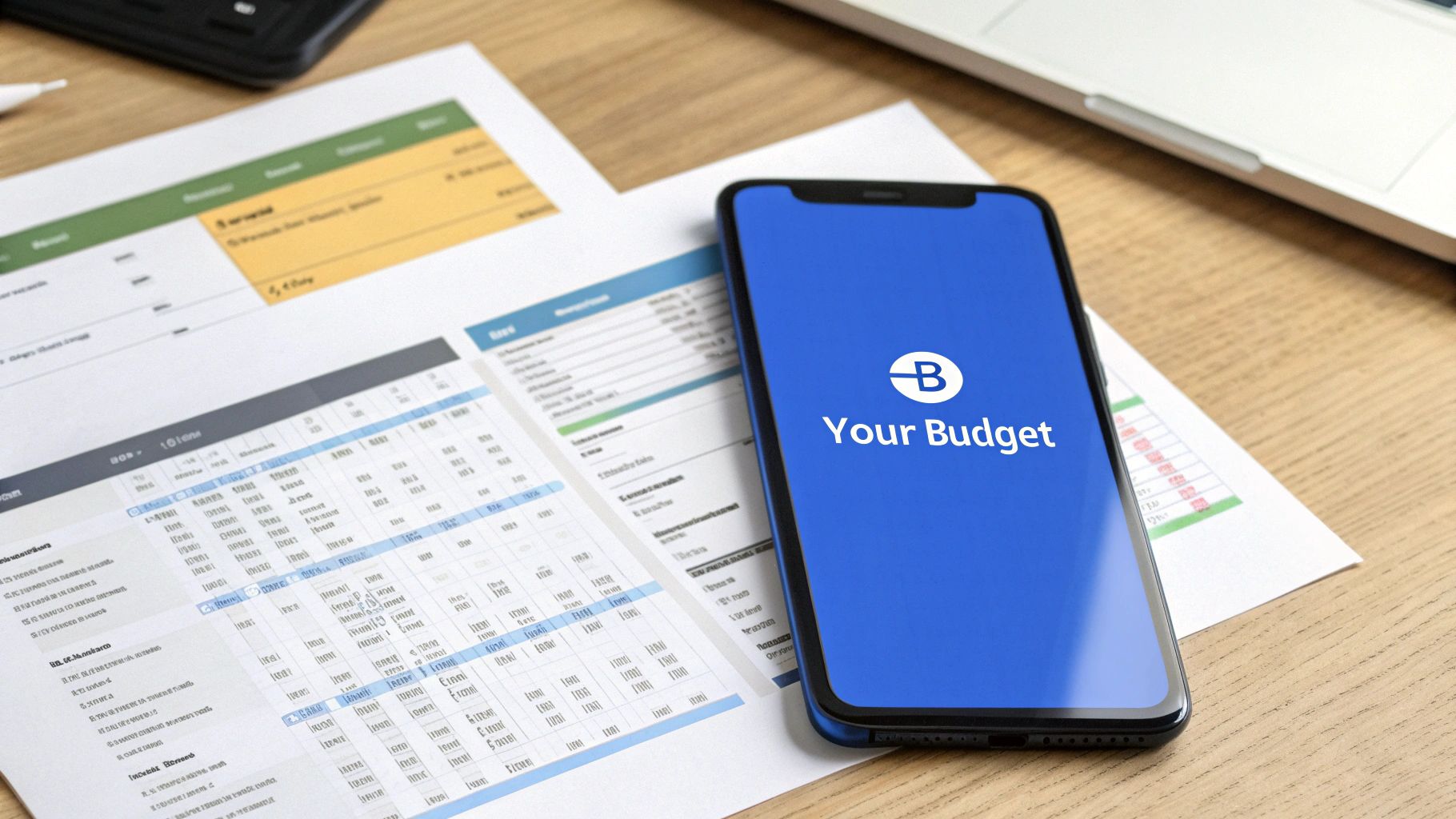Our Marketing Team at PopaDex
How to Organize Finances: Easy Tips for Better Money Management

Getting Real About Where Your Money Actually Goes

Before you can get a real handle on your finances, you need to take a clear, honest look at where you are right now. This isn’t about shaming yourself for that spontaneous vacation or the takeout habit that got a little out of hand. It’s simply about establishing a baseline. Think of it like a doctor checking your vitals before creating a health plan—without that initial data, any budget is just a shot in the dark.
If the thought of facing your bank statements makes you a little queasy, you’re not alone. It’s a very common feeling. In fact, a 2024 study found that only 36% of U.S. households have a written long-term financial plan, and a staggering 27% have no emergency savings at all. These personal finance statistics and what they mean for you show that feeling financially scattered is more the norm than the exception.
Your Financial Starting Line: Assets and Liabilities
The single most powerful thing you can do first is calculate your net worth. This isn’t some high-finance term reserved for corporate executives; it’s a practical number for everyone. The formula is beautifully simple: what you own (assets) minus what you owe (liabilities).
Your first move is to gather all your financial paperwork. It might feel like a bit of a scavenger hunt, but it’s an essential one. You can use a notebook or a simple spreadsheet to create two columns.
Assets Column (What you own):
- Balances from all your checking and savings accounts.
- The current value of investment accounts, like a 401(k) or brokerage account.
- A realistic market value for your home or car (a quick search on Zillow or Kelley Blue Book can give you a good estimate).
- Anything else valuable that you could realistically sell, like jewelry or collectibles.
Liabilities Column (What you owe):
- The total balance on all your credit cards.
- Your outstanding student loan debt.
- The remaining balance on your mortgage.
- Any car loans or other personal loans.
Once you have totals for both columns, subtract your liabilities from your assets. The number you’re left with is your net worth. Don’t panic if it’s negative—many people, especially those just starting out with student loans or a mortgage, are in the same boat. This number isn’t a report card; it’s just your starting point on a map. From this moment on, every smart financial choice you make can be seen in how this number improves over time. This is exactly where a tool like PopaDex can be a game-changer, as it automates this calculation and provides a live dashboard of your financial health.
Simplifying Your Financial Infrastructure Like a Pro
Now that you have a clear picture of your financial starting line, it’s time to tackle the structural mess. Many of us collect bank accounts over the years—an old student account, a joint account from a past relationship, or a high-yield savings account we opened for a bonus and then forgot. Each one adds another layer of complexity, making it harder to track your money and potentially costing you in fees. The goal here isn’t just tidiness; it’s about creating a system that actively helps you reach your financial goals.
I once saw this firsthand with a friend, a freelance designer, who was juggling five different checking accounts. He thought he was being organized by separating client payments, but in reality, he was constantly shuffling money to avoid minimum balance fees and overdrafts. His breakthrough came when he consolidated into just two accounts: one for all business income and expenses, and one for his personal finances. This simple change gave him immediate clarity on his business profitability and personal spending. It’s a perfect example of how organizing your finances often starts by simplifying your setup.
A Practical Consolidation Framework
Instead of blindly closing accounts, it’s better to evaluate each one with a critical eye. Start by asking a few key questions:
- What is this account’s specific job? Does it receive your paycheck, hold your emergency fund, or house your investments? If it doesn’t have a clear, distinct purpose, it might be redundant.
- Are there fees attached? Monthly maintenance fees, even small ones, are a needless drain on your resources. An account that costs you money just to exist is rarely worth keeping.
- Does this institution meet my needs? Think about interest rates, the quality of customer service, and the digital tools available. Your bank should work for you, not the other way around.
To help with this process, I’ve put together a table comparing essential accounts with those that might be adding unnecessary clutter. It provides a clear framework for deciding what to keep and what to close.
Essential vs. Optional Financial Accounts Comparison
A practical comparison showing which financial accounts are necessary for organization versus those that might be creating unnecessary complexity
| Account Type | Essential Level | Organization Benefits | Common Pitfalls |
|---|---|---|---|
| Primary Checking Account | Essential | Central hub for income (paychecks) and primary bill payments. Simplifies tracking of regular cash flow. | High fees if minimum balances aren’t met; low or no interest earned. |
| High-Yield Savings Account | Essential | Houses your emergency fund and short-term savings goals (e.g., vacation, car). Earns higher interest than checking. | Withdrawal limits (often 6 per month); variable interest rates that can drop. |
| Retirement Accounts (401k/IRA) | Essential | Dedicated long-term wealth building with tax advantages. Keeps retirement funds separate and protected. | Early withdrawal penalties; complex investment choices can feel overwhelming. |
| Brokerage Account | Optional (but Recommended) | For non-retirement investments, allowing you to build wealth with stocks, ETFs, etc. | Market risk and potential for loss; can become complex with too many small positions. |
| Multiple Savings Accounts | Optional | Can be useful for “sinking funds” (specific goals), but can also create clutter. | Can lead to analysis paralysis and difficulty tracking overall savings progress. |
| Old/Forgotten Accounts | Non-Essential | No real benefit; often just an administrative and security liability. | Dormancy fees, forgotten balances, and increased risk of identity theft. |
This comparison highlights that a streamlined setup—usually a checking, a high-yield savings, and your retirement accounts—is all most people need for a strong financial foundation.
This bar chart shows the three most important numbers to track monthly: your income, expenses, and savings.

The visualization makes it obvious that the gap between income and expenses is where your power lies—this is your savings potential. By simplifying your accounts, you reduce the financial noise and make it easier to see and grow this crucial number. A streamlined system is also the perfect foundation for automation. You can learn more about how to automate your finances to build wealth effortlessly in our detailed guide. Reducing the number of accounts you manage makes setting up automatic transfers for savings and investments much more straightforward.
Building a Budget That Fits Your Actual Life
 With your accounts simplified, the next part of learning how to organize finances is building a budget—but probably not the kind you’re picturing. Forget those strict spreadsheets that make you feel guilty for buying a coffee. A good budget is really just a flexible spending plan that works with your real life, not some perfect version of it. It needs to be able to handle an occasional splurge or an unexpected car repair without falling apart.
With your accounts simplified, the next part of learning how to organize finances is building a budget—but probably not the kind you’re picturing. Forget those strict spreadsheets that make you feel guilty for buying a coffee. A good budget is really just a flexible spending plan that works with your real life, not some perfect version of it. It needs to be able to handle an occasional splurge or an unexpected car repair without falling apart.
The point isn’t to make yourself miserable by cutting out everything you enjoy. It’s about telling your money where to go with intention. A fantastic way to begin is by adopting a “Pay Yourself First” mindset. Before you even think about bills or groceries, decide how much you want to save—no matter how small—and set up an automatic transfer to your savings account right after payday. This one move changes the game from saving whatever is left over to making your future a top priority.
Finding a Budget Style That Clicks
There’s no single budget that works for everyone. If you’re a freelancer with an income that goes up and down, you’ll need something different from a person with a steady paycheck every two weeks. The trick is to find a system that matches your personality and financial situation. Some of the more popular and adaptable methods include:
- The 50/30/20 Rule: This is a simple guideline where 50% of your take-home pay is for needs (like rent and utilities), 30% is for wants (like dining out and hobbies), and 20% goes toward savings and paying off debt.
- Zero-Based Budgeting: With this method, every single dollar has a job. At the beginning of the month, you assign all of your income to different spending categories until your income minus your expenses equals zero. It requires attention to detail but gives you total control.
- Value-Based Spending: You figure out what’s most important to you—maybe it’s travel or eating at great restaurants—and spend generously on those things while cutting back hard on stuff you don’t really care about.
The challenge of sticking to a budget can be made tougher by outside economic pressures. For instance, recent U.S. data shows that medical costs have jumped by 33% in the last ten years, growing much faster than the average income. You can read more about these kinds of influential financial statistics on The Tokenist. This reality means many people have to put more of their budget toward necessities, making a flexible financial plan more important than ever.
Ultimately, the best approach is the one you’ll actually use. Don’t be afraid to experiment. You might discover that mastering budgeting is a path to financial freedom by mixing and matching elements from different methods to create a personalized system that works just for you.
Smart Expense Tracking Without the Obsession
Once you’ve got your accounts sorted and a flexible budget in place, the next part of learning how to organize finances is figuring out where your money actually goes. Let’s be real: obsessing over every single coffee purchase is a quick path to burnout. But if you completely ignore your spending, you’re just flying blind. The goal is to find that sweet spot of mindful awareness, not painful micromanagement. You don’t need to track every penny, but you do need to understand the major currents moving your money.
Think of it like this: a smart business owner doesn’t count every paperclip, but they know their big costs like payroll, rent, and marketing inside and out. Your personal finances follow the same principle. Focus on the big-ticket items and recurring charges that really shape your budget.
Pinpointing What Really Matters
Instead of getting lost in the tiny details, direct your tracking efforts to the categories that have the biggest impact. These are usually the same areas that can spiral out of control if you aren’t paying attention.
- Variable Spending: This is where things like groceries, dining out, and gas live. These expenses can change drastically from one month to the next and are often where a budget first starts to crack.
- Subscriptions: Remember that free trial you forgot to cancel? Or the three streaming services you hardly ever watch? These small, repeating charges can add up to a significant amount over time. A quick quarterly review can often find you an extra $50 or more per month.
- “Fun” Money: This bucket holds everything from entertainment and shopping to your hobbies. It’s essential to have this category for your well-being, but it also needs clear boundaries. Tracking it helps you see if you’re spending on things that bring you real joy, or just mindlessly swiping your card.
Leveraging Technology for Effortless Tracking
Let’s face it, manually typing every expense into a spreadsheet is a chore very few people can stick with long-term. This is where modern tools can take on the heavy lifting for you. The growth of financial technology has made smart expense tracking available to everyone. In fact, the global market for personal finance apps was valued at around $132.92 billion in 2024 and is expected to keep growing as more people look for easier ways to manage their money. You can find out more about this boom in personal finance tech on The Business Research Company.
Platforms like PopaDex can automatically categorize your transactions by linking to your bank accounts, giving you a clear picture of your spending without all the manual work. You can see at a glance if your grocery bill is creeping up or if you’ve spent more on takeout than you thought. This automated system changes your job from data-entry clerk to financial decision-maker, letting you focus on adjusting your habits based on clear, accurate information. It’s the perfect way to stay connected to your spending without letting the task take over your life.
Strategic Wealth Building Through Organized Systems
After you’ve sorted out your accounts and nailed down a budget that works, it’s time for the fun part: making your money work for you. Real financial organization is more than just paying bills on time. It’s about building a system to deliberately create wealth. This is the moment you switch from playing defense (cutting costs, avoiding debt) to offense—actively building the future you want. It’s not just about saving; it’s about strategically putting your money toward goals that truly matter, from a solid emergency fund to a comfortable retirement.
Prioritizing Your Financial Goals
One of the biggest hurdles people face is trying to save for everything at once. You might put a little cash toward retirement, a bit toward a house down payment, and a small amount into a vacation fund. While the intention is good, this approach often leaves you feeling like you aren’t making real progress on any single goal. A smarter strategy is to prioritize. A common and effective hierarchy looks like this:
- First, build your emergency fund. Before you get into serious investing, you need a financial safety net. Your goal should be 3 to 6 months of essential living expenses tucked away in a high-yield savings account. This fund is your shield, preventing you from derailing long-term investments when an unexpected expense—like a car repair or medical bill—pops up.
- Next, tackle high-interest debt. Any debt with an interest rate above 7-8%, such as credit card balances or personal loans, should be treated like a financial emergency. The interest you’re paying is almost certainly higher than any guaranteed return you could get from investing. Paying it off gives you an immediate, guaranteed return on your money.
- Then, focus on retirement and long-term investing. Once your emergency fund is healthy and your high-interest debt is gone, you can go all-in on long-term growth. This means contributing enough to your 401(k) to get the full employer match—it’s literally free money—and then putting more into other retirement or brokerage accounts.
This is where a clear dashboard makes a huge difference, showing you exactly how you’re progressing in each of these distinct buckets.

Seeing your net worth grow in a personal finance dashboard provides the motivation you need to stick with your plan. It transforms abstract numbers into tangible proof that your organized system is working.
To help you map this out, a priority matrix can be incredibly useful. It forces you to think strategically about where each dollar should go based on what’s most important right now.
| Goal Type | Priority Level | Timeline | Recommended Allocation % | Tracking Method |
|---|---|---|---|---|
| Emergency Fund | Critical | 0-12 months | 50-100% of savings | High-Yield Savings Account |
| High-Interest Debt | High | 6-24 months | 50-75% of savings | Debt Paydown Calculator |
| Retirement (401k Match) | High | Long-Term | % to secure full match | Retirement Account Portal |
| House Down Payment | Medium | 1-5 years | 20-30% of savings | Dedicated Savings Account |
| Vacation Fund | Low | 6-18 months | 5-10% of savings | Sinking Fund in Budget App |
This matrix isn’t just a list; it’s a framework for action. Once you’ve fully funded your critical-priority goal (the emergency fund), you can reallocate that portion of your savings to the next priority, creating a powerful snowball effect for your wealth.
This disciplined approach is what allows your money to grow most effectively. To really grasp the mechanics of how your money multiplies, it’s worth learning about compound interest daily vs monthly. Understanding this concept is the key to appreciating why consistent, long-term investing is so powerful. By focusing on one main goal at a time before moving to the next, you build momentum and see concrete results much faster, which is essential for staying motivated on your financial journey.
Maintaining Financial Organization When Life Gets Messy
Putting a financial system in place is one thing, but making it stick when life throws a curveball is the real challenge of learning how to organize finances. A new job, an unexpected medical bill, or welcoming a baby can easily derail even the most carefully crafted budget. The key to staying on track isn’t about having more willpower; it’s about building a system that’s flexible enough to bend without breaking.
A rigid plan will almost always shatter under real-world pressure. Major life events aren’t just emotional—they carry a significant financial weight. For instance, the first year with a new baby can bring a wave of new costs, from one-time purchases like a crib to recurring expenses like daycare. A budget built for two people suddenly needs to adapt for three, forcing a total rethink of spending habits and savings goals.
Adjusting Your Systems for Life’s New Realities
Your financial organization needs to evolve as your life does. What worked perfectly last year might be completely unsuitable today. The secret is to treat your financial plan not as a set of strict rules, but as a living document that changes with you.
- Schedule Quarterly Financial Reviews: Don’t wait for a crisis to review your finances. Set a calendar reminder every three months for a “money date” with yourself or your partner. During this check-in, compare your budget to your actual spending, check your progress toward goals, and ask, “Does this plan still fit our life?” This proactive habit helps you make small fixes before they turn into big problems.
- Build a “Life Happens” Fund: This isn’t your main emergency fund for major disasters. Instead, it’s a smaller, separate savings account for predictable but irregular expenses—think new tires for the car, a surprise vet visit, or a broken washing machine. Having this buffer keeps you from raiding your primary emergency savings for minor setbacks.
- Automate What You Can, Forgive the Rest: When you’re stressed or overwhelmed, the last thing you want to deal with is manually managing your money. Keep your automated savings and investment transfers active. If your discretionary spending gets a little messy one month, that’s okay. The automated progress ensures you’re still moving forward, even when you’re not operating at 100%.
The goal isn’t perfection; it’s financial resilience. By designing a flexible system and practicing regular, low-stress check-ins, you can create money habits that withstand the beautiful messiness of life.
Your Financial Organization Action Plan
Turning financial chaos into clarity doesn’t happen with a single click. It’s about building momentum through small, consistent actions. Think of this as your roadmap, turning abstract ideas into a practical plan. The goal isn’t instant perfection but steady progress toward feeling in control of your money.
Your First 30 Days: The Foundation Phase
This initial month is all about creating clarity and setting up your systems. Don’t try to tackle everything at once. Instead, focus on these core tasks to build a solid foundation you can rely on for years to come.
-
Week 1: Get Your Financial Snapshot. Your only job this week is to gather every piece of your financial puzzle. This means logging into all your bank accounts, credit cards, loans, and investment platforms. Tally it all up to calculate your starting net worth (what you own minus what you owe). This single number is your new baseline for success.
-
Week 2: Consolidate and Simplify. Look at the account list you made last week. Can you spot any redundancies? Now is the time to close those extra accounts that just add clutter. If you don’t already have one, open a high-yield savings account. The aim is a streamlined system: one main checking account, one primary savings account, and your investment accounts.
-
Week 3: Draft Your Spending Plan. Choose a budgeting method that actually feels doable for you. Maybe it’s the popular 50/30/20 rule, or perhaps value-based spending aligns better with your goals. Remember, this isn’t about restriction; it’s about creating a rough guide for where your money goes.
-
Week 4: Put Your Priorities on Autopilot. It’s time to set up two crucial automatic transfers. The first one should go to your high-yield savings account to build your emergency fund. The second should be directed to your retirement account. Automating your savings is the single most effective way to ensure you pay yourself first.
Maintaining and Optimizing Your System
Once your foundation is in place, staying financially organized becomes a simple maintenance routine. It’s less of a huge project and more of a small, powerful habit.
Schedule a 30-minute “money check-in” on your calendar, maybe for the first Sunday of every month. Use this time to review last month’s spending, check in on your savings goals, and make small tweaks to your budget. If you notice a category like dining out is consistently over budget, don’t beat yourself up. Instead, ask why, and adjust the number to be more realistic for your lifestyle.
The key to long-term success is building a system that can handle life’s unexpected turns. A well-organized financial life gives you the stability to manage unexpected events without completely derailing your future.
Ready to see all your hard work in one place? Sign up for PopaDex today to get a clear, real-time view of your complete financial picture and track your progress effortlessly.